
Henry Beaufort, 3rd Duke of Somerset was an important Lancastrian military commander during the English Wars of the Roses. He is sometimes numbered the 2nd Duke of Somerset, because the title was re-created for his father after his uncle died. He also held the subsidiary titles of 5th Earl of Somerset, 2nd Marquess of Dorset and 2nd Earl of Dorset.

Duke of Beaufort is a title in the Peerage of England. It was created by Charles II in 1682 for Henry Somerset, 3rd Marquess of Worcester, a descendant of Charles Somerset, 1st Earl of Worcester, legitimised son of Henry Beaufort, 3rd Duke of Somerset, a Lancastrian leader in the Wars of the Roses. The name Beaufort refers to a castle in Champagne, France. It is the only current dukedom to take its name from a place outside the British Isles.
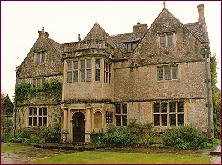
St Catherine's Court is a manor house in a secluded valley north of Bath, Somerset, England. It is a Grade I listed property. The gardens are Grade II* listed on the Register of Historic Parks and Gardens of special historic interest in England.

Badminton is a village and civil parish in South Gloucestershire, England. The only settlement in the parish is Badminton village, sometimes called Great Badminton to distinguish it from the hamlet of Little Badminton, about one mile to the north in Hawkesbury parish. The large country house called Badminton House is close to the north end of the village, and its surrounding deer park lies to the north and west.

David Robert Somerset, 11th Duke of Beaufort GCC, known as David Somerset until 1984, was an English peer and major landowner.

Henry Hugh Arthur FitzRoy Somerset, 10th Duke of Beaufort, styled Marquess of Worcester until 1924, was a peer, landowner, society figure and a great authority in the fields of horse racing and fox-hunting. He held the office of Master of the Horse for over forty years (1936–1978), the longest to hold the position. He founded the Badminton Horse Trials and was deemed "the greatest fox-hunter of the twentieth century"; his long tenure as Master of the Beaufort Hunt led to his being universally nicknamed Master and his car bore the private numberplate MFH1. In 1980 he published the authoritative book Fox-Hunting.

Victoria Constance Mary Somerset, Duchess of Beaufort, CStJ was a British peeress and sportswoman. The elder daughter of the 1st Marquess of Cambridge and Lady Margaret Grosvenor, she was the niece of Queen Mary.

Raglan (; is a village and community in Monmouthshire, south-east Wales, United Kingdom. It is located some 9 miles south-west of Monmouth, midway between Monmouth and Abergavenny on the A40 road very near to the junction with the A449 road. It is the location of Raglan Castle, built for William ap Thomas and now maintained by Cadw. The community includes the villages of Llandenny and Pen-y-clawdd. Raglan itself has a population of 1,183.

Welbeck Abbey is an English mansion situated in the village of Welbeck, which is within the civil parish of Norton, Cuckney, Holbeck and Welbeck, in the Bassetlaw District of Nottinghamshire. It was the site of a monastery belonging to the Premonstratensian order in England and after the Dissolution of the Monasteries, a country house residence of the Dukes of Portland. It is part of the Dukeries, four contiguous ducal estates in North Nottinghamshire. The house is a Grade I listed building.
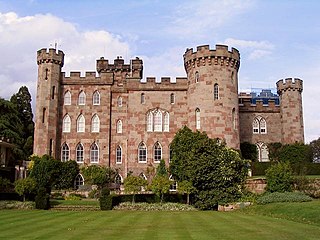
Cholmondeley Castle is a country house in the civil parish of Cholmondeley, Cheshire, England. Together with its adjacent formal gardens, it is surrounded by parkland. The site of the house has been a seat of the Cholmondeley family since the 12th century. The present house replaced a timber-framed hall nearby. It was built at the start of the 19th century for George Cholmondeley, 1st Marquess of Cholmondeley, who designed most of it himself in the form of a crenellated castle. After the death of the Marquess, the house was extended to designs by Robert Smirke to produce the building in its present form. The house is designated by English Heritage as a Grade II* listed building.
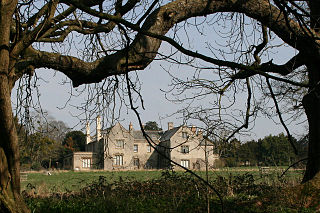
Poundisford Park north of Pitminster, Somerset, England is an English country house that typifies progressive housebuilding on the part of the West Country gentry in the mid-16th century. The main house was built for William Hill around 1550 and has been designated as a Grade I listed building.

Wigborough Manor House is a manor house in South Petherton, Somerset, England. It was partly built in 1585, although it was never completed to the original designs and was subsequently modified. It has been designated as a Grade I listed building.

Troy House is a Welsh historic house, on a "ducal" scale, north-east of Mitchel Troy, Monmouthshire. The original house belonged to Blanche Herbert, Lady Troy, of the Herbert family of Raglan Castle, who owned great estates in South Wales as Marquesses of Worcester and later Dukes of Beaufort. The present structure, overlooking the River Trothy was constructed from 1681 to 1684 as a wedding present for Charles Somerset by his father, Henry Somerset, 1st Duke of Beaufort. Troy House is a Grade II* listed building and its gardens and park are listed, also at Grade II*, on the Cadw/ICOMOS Register of Parks and Gardens of Special Historic Interest in Wales.

The Dower House, Stoke Park is a dower house in Bristol, England. It is one of Bristol's more prominent landmarks, set on Purdown, a hill above the M32 motorway on the main approach into the city, and painted yellow.
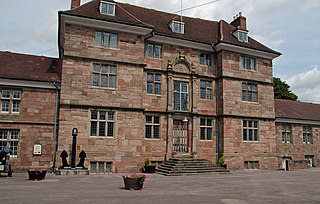
Great Castle House is a former town house built on the site of part of Monmouth Castle in Wales. Amongst the town's most significant buildings, it has a Grade I listing and is one of 24 sites on the Monmouth Heritage Trail. The house is located on Castle Hill, off Agincourt Square in Monmouth town centre.
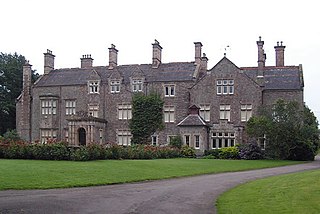
Cefntilla Court,, Llandenny, Monmouthshire, Wales, is a country house dating from the mid-19th century. Its origins date from 1616. During the English Civil War, the court was the headquarters of Thomas Fairfax during the siege of Raglan Castle and the terms of the castle's surrender were signed at the house in 1646. By the early 19th century, the court was derelict. In 1856 it was sold by Crawshay Bailey to the Memorial Committee established to commemorate the life of FitzRoy Somerset, 1st Baron Raglan, British commander during the Crimean War. The house was completely rebuilt by Thomas Henry Wyatt and donated to Lord Raglan's heir, Richard Somerset as a memorial to his father. The house is a Grade II* listed building.

St Michael and All Angels is a Grade I listed church on the estate of the Duke of Beaufort in the village of Great Badminton, Gloucestershire, England. Attached to the Duke of Beaufort's residence, Badminton House, it is an active Anglican parish church in the diocese of Gloucester. Although within the grounds of the Badminton Estate, the church is owned, and its upkeep met, by the Badminton's Parochial Church Council, rather than the Ducal estate. There is a smaller church of the same name in the neighbouring hamlet of Little Badminton.
Duchess of Beaufort is a title held by the wife of the Duke of Beaufort in the Peerage of England. In 1657 Henry Somerset, 3rd Marquess of Worcester married Mary Capell and in 1682 the dukedom was created by Charles II, making Henry the first Duke and Mary the first Duchess of Beaufort.

John Symes Berkeley (1663–1736) of Stoke Gifford near Bristol was an English Member of Parliament.

The Somerset Monument in Hawkesbury Upton, Gloucestershire, England was built in 1846 to commemorate Lord Robert Edward Somerset. It is a Grade II* listed building, and on the Heritage at Risk register.
























